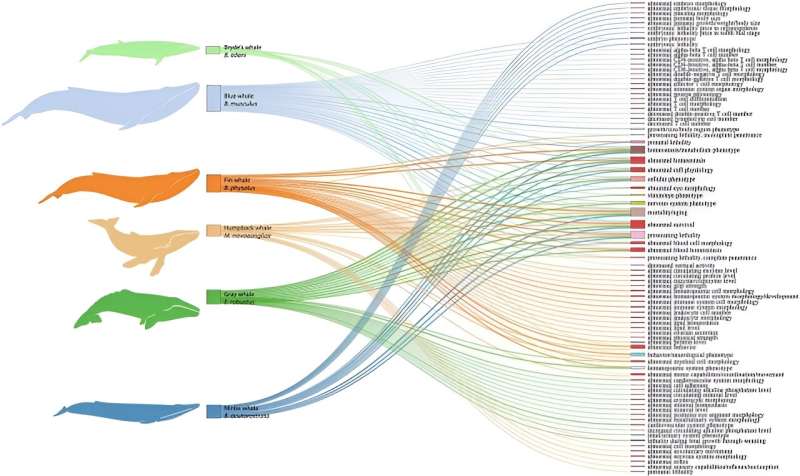This article has been reviewed according to Science X's editorial process and policies. Editors have highlighted the following attributes while ensuring the content's credibility:
fact-checked
trusted source
proofread
Into the blue: How baleen whales have adapted over the past 50 million years

The largest dataset of cetacean genes ever collated has helped Flinders University scientists deep dive into the blue to fathom the triumph of baleen whale evolution.
The new study, published in the journal Gene titled "Into the Blue: Exploring genetic mechanisms behind the evolution of baleen whales," explores the key genetic adaptations of these diverse whale species around the world's vast oceans—giving new insights into the risks and opportunities for their survival.
"We actually know very little about the genetic diversity of modern whales, compared to terrestrial animals, so these insights give fresh information about their radiation and changes over the past 50 million years," says Ph.D. candidate Gabrielle Genty, from the College of Science and Engineering, Flinders University.
The study helps to explain the intriguing mammals—from the gigantism of the largest blue and fin whales, to the diving and migratory abilities of other baleen whales, including humpbacks, minkes and gray whales.
While genes linked to survival, aging, movement, immunity and reproduction were highlighted, future adaptations will need to respond to climate change and other threats including marine pollution and diseases, researchers say.
"For example, we found genes that improve immunity have been important for the largest species, fin whales and the world's largest animal, the blue whale," says Genty, from the Flinders Cetacean Ecology, Behaviour and Evolution Lab (CEBEL) and Molecular Ecology Lat at Flinders University (MELFU).
"There additional adaptations related to the immune system may help these species achieve their large size without suffering detrimental health issues like tumors and cancer, which are typically associated with increased body size and rapid cell generation."
The research used a dataset of 10,159 genes, across 15 cetacean species and two terrestrial species—hippos and cows (Hippopotamus amphibius and Bos taurus)—which are the considered the closest land relatives of whales.
Baleen whales are highly mobile and pelagic, so studying them is challenging.
Senior co-author, Flinders University Associate Professor Luciana Möller, says cetaceans (whales, dolphins and porpoises) have diversified into myriad groups since they left land for their aquatic world in history.
This diversification resulted in a minimum of 89 main species, divided into two main suborders: 74 belonging to Odontoceti (toothed whales, dolphins and porpoises) and 15 to Mysticeti (baleen whales), which possess baleen plates for filter-feeding—compared to Odontoceti or toothed whales.
The latest study focuses on balaenopterids (the Balaenopteridae family within the Mysticeti), which are represented by nine recognized species distinguished by the presence of grooves over the throat and chest, their ability to undertake migrations spanning vast parts of the globe, and for calves to grow very rapidly.
Genty says, "By identifying positively selected genes and enriched mammalian phenotypic terms, this research highlights the genetic and physiological adaptations that underpin the diversification and specialization of balaenopterids."
Associate Professor Möller says this wide-ranging study provides further evidence of the success of baleen whale adaptive evolution.
"This allowed them to thrive in their aquatic habitat and diversify into distinct species with variations in size, morphology, mating systems, feeding strategies and diving abilities," she says.
"The work advances our understanding of the genetic mechanisms behind the evolution of baleen whales, offering new insights into their evolutionary triumph."
Recent research suggests that a massive size increase was the last step in the evolution of present-day whales, likely driven by the improved thermal isolation of larger body sizes. In addition, baleen whales present a wide range of feeding mechanisms related to a range of energetic strategies and ecological niches.
Despite similar body shapes, balaenopterids range from the small common minke whale (Balaenoptera acutorostrata), reaching approximately 7–8 m in length, to the largest mammal on Earth, the blue whale (Balaenoptera musculus), exceeding 30 m.
More information: Gabrielle Genty et al, Into the Blue: Exploring genetic mechanisms behind the evolution of baleen whales, Gene (2024). DOI: 10.1016/j.gene.2024.148822
Provided by Flinders University





















